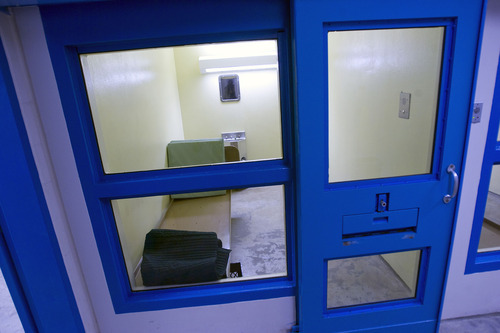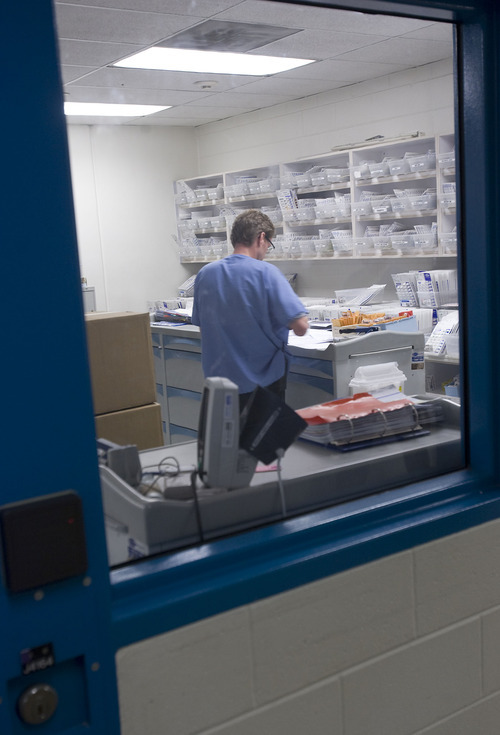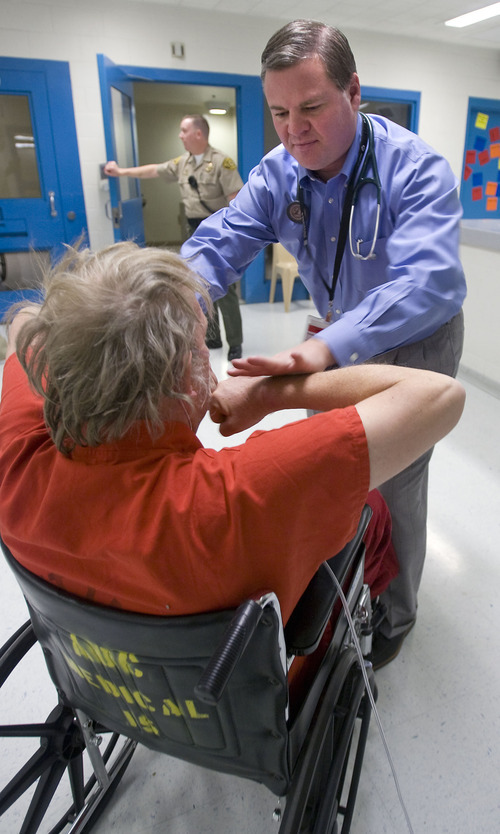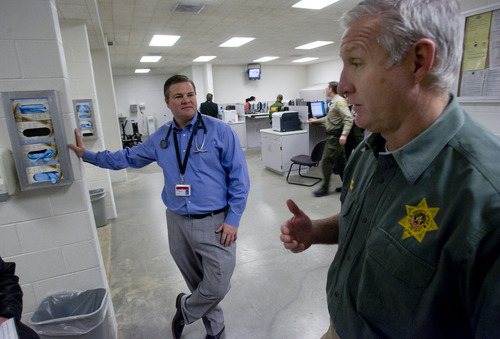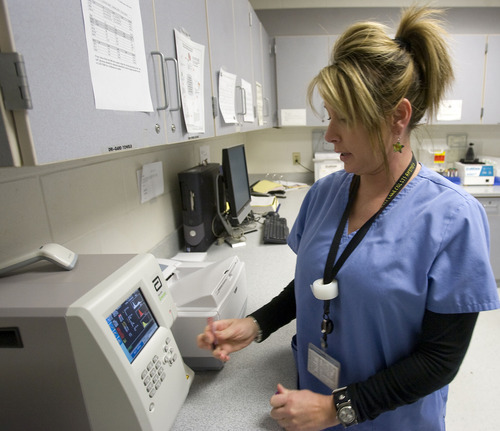This is an archived article that was published on sltrib.com in 2011, and information in the article may be outdated. It is provided only for personal research purposes and may not be reprinted.
The patient in red scrubs has a history of heart attacks and deep vein thrombosis. He's on oxygen, and barely lifts his head as a physician listens to his heart. Out on the street, he's capable of drinking a half-gallon of cheap booze a day.
Not here, though, in the acute medical unit of the Salt Lake County Metro Jail. After the brief exam, the man is returned to his modest hospital bed in a one-person cell with glass doors and windows.
The medical facility — including a mental health unit — is basically a hospital, with sophisticated labs and a pharmacy but without surgical suites. Inmates can receive rudimentary dental care, mostly extractions of teeth damaged by wear, lack of hygiene or drug abuse, particularly methamphetamine.
It's housed in a huge, windowless building that on any given day houses some 2,200 men and women jailed for everything from shoplifting or drunken driving to murder. Over a year, some 55,000 people will rotate in and out.
The jail is overseen by Salt Lake County Sheriff Jim Winder, a career cop who's proud of the jail and its medical unit, and is one of 40 such facilities nationwide accredited by the National Commission on Correctional Health Care.
"That demonstrates our commitment to a reasonable and humane level of treatment," Winder says. "We are not immune from complaints from the public, who say, 'Gee, how dare these people get better treatment than we do on the outside?'
"I'd be lying if I would say that is not the case, because on the outside, some people get zero," he says. "We're in a unique situation — we have a moral, legal, ethical responsibility to ensure [inmates] are treated."
That's not to say jailhouse treatments are expansive and expensive. The medical unit's roughly $7 million yearly budget can't allow that.
For inmates who need hospitalization for surgeries and childbirth, or are admitted to nursing homes or intermediate care, Medicaid has recently been made available to those who are over 64, pregnant or who meet the Social Security definition of disability.
That would mean, for example, that Medicaid would be available to a woman with a high-risk pregnancy, providing 70 percent of the cost of a $35,000 delivery. That's a big deal for taxpayers who foot the bill for jail funding, Winder says.
It's an even bigger deal for the women, who are likely to have histories of drug or alcohol abuse. Medicaid can provide a continuity of coverage that Winder believes is a "real opportunity to keep families whole. Some may ask, 'Why did the drug-taking mom even have her kids?' If you look at statistics, they're better off with their kids.
"We're humane here," the sheriff reiterates. "We've not in the business of cleaving people from their families because of a dependence, necessarily."
But before anyone gets into the jail, they must go through the processing area, where nurses evaluate the suspects to determine whether they can be allowed to enter.
An officer might report, for example, there's been a traffic accident, with air bags deployed and the person banged up.
"At the scene, they seem all right, but when we get them, a pupil may be dilated, or [the suspect] has lacerations," Winder says.
The officers' objective is to get suspects admitted so they can get back to patrol. When that can't happen, the nurses call for EMTs and an ambulance to take the suspect to a hospital, which also has an ethical obligation to provide care.
Another problem can arise when suspects are too sick or intoxicated to be booked into jail. Some officers will "take them out to 700 West and dump them off," Winder says. "I feel compelled to tell you this."
The jail is in South Salt Lake, which means that city's emergency personnel must pick those people up and get them care. Winder believes that's an unfair burden on the city.
In the processing center, a person must have a checkup before being booked. Medical director Todd Wilcox, a physician, says nurses look for major problems — a high-speed collision or being brought down by a police dog — that might require hospitalization.
They're also on the lookout for contagious diseases — mumps, chicken pox, tuberculosis and the like. Medical records are kept on anyone booked into jail, which is helpful because many are repeat offenders, Wilcox says.
The jail does accept prisoners who need, for example, insulin for diabetes. Some go to the medical unit, but many are put in the general population and nursing staff tend to them there.
"It facilitates a smooth operation and it's much safer," Winder says. "A good 75 percent of our treatment is managed [in exam rooms] inside the housing units."
Others may arrive with a history of heavy medication, typically narcotics and psychotropics.
"We get them in there and take them off that stuff. The surprising thing is, from my standpoint, is that very commonly we see a new human being emerge," he says. "In my humble, non-medical opinion, we see that about 95 percent of that crap is absolutely unnecessary and complicating."
When a person genuinely needs such drugs, the medical staff will do that on a management — not therapeutic — level.
Of course, some newcomers may have a severe mental issue, or have gone off their prescribed meds and compensated by turning to alcohol or recreational drugs. Along the way, many turn to low-level criminality and can have dozens of arrest warrants.
Some professing to be suicidal will go straight to the acute unit, Winder say, where they'll be closely monitored.
My two-hour tour of the jail was coming to an end, and we walked through the maze of corridors to reach sunlight and fresh air. Thinking of the man in the red scrubs, I realize that humane, respectful treatment is the essence of good policy and good medicine — whether it's delivered in a hospital or a county jail.
Peg McEntee is a news columnist. Reach her at pegmcentee@sltrib.com and facebook.com/pegmcentee.


